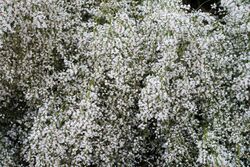Biology:Retama monosperma
| Retama monosperma | |
|---|---|

| |
| Scientific classification | |
| Kingdom: | Plantae |
| Clade: | Tracheophytes |
| Clade: | Angiosperms |
| Clade: | Eudicots |
| Clade: | Rosids |
| Order: | Fabales |
| Family: | Fabaceae |
| Subfamily: | Faboideae |
| Genus: | Retama |
| Species: | R. monosperma
|
| Binomial name | |
| Retama monosperma (L.) Boiss.
| |
| Synonyms[1] | |
| |
Retama monosperma, the bridal broom[2] or bridal veil broom, is a flowering bush species in the genus Retama, native to the parts of the Mediterranean Basin (Algeria, Morocco, Portugal and Spain in the west, Egypt, the East Aegean Islands and Greece in the east). It has been introduced elsewhere.[1]
Retama monosperma forms root nodules with Ensifer fredii. The larvae of the moths Phyllonorycter hesperiella and Phyllonorycter spartocytisi feed on R. monosperma.
The seeds contain cytisine, a toxic alkaloid. Fifteen other quinolizidine and three dipiperidine alkaloids can also be isolated from different parts of the plant. In particular, the presence of (+)-sparteine, α- and β-isosparteine, (+)-17-oxosparteine, (-)-lupanine, 5,6-dehydrolupanine, (-)-anagyrine, (-)-N-methylcytisine and (+)-ammodendrine can be detected.[3]
References
- ↑ 1.0 1.1 "Retama monosperma (L.) Boiss.." (in en). Royal Botanic Gardens, Kew. http://www.plantsoftheworldonline.org/taxon/517085-1.
- ↑ "Retama monosperma". Natural Resources Conservation Service PLANTS Database. USDA. https://plants.usda.gov/core/profile?symbol=REMO2. Retrieved 20 October 2015.
- ↑ Alkaloids from Retama monosperma ssp. eumonosperma. Touati D, Allain P, Pellecuer J, Fkih-Tetouani S and Agoumi A, Fitoterapia, 1996, volume 67, number 1, pages 49-52, INIST:3027852
External links
Wikidata ☰ Q966251 entry
 |

